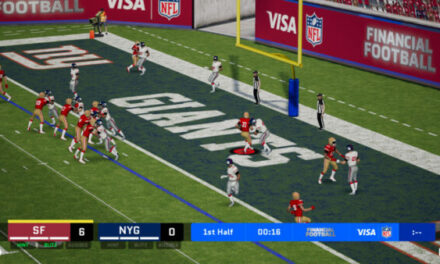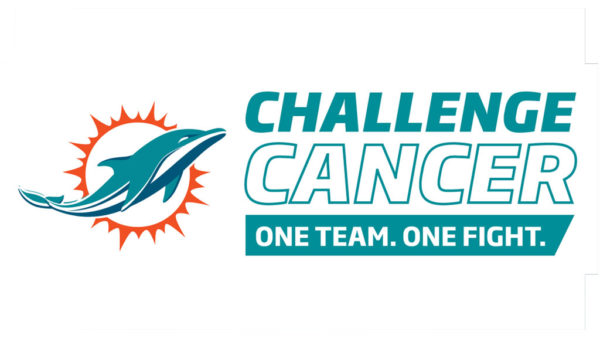State Of The Dolphins
Travis Wingfield
Despite a four-game improvement from 2015 and the club’s
first playoff appearance since 2008, the Dolphins’ critics carry-on crediting
smoke and mirrors for the turn around. Admittedly, not even the most rabid fan would
agree that Miami are without holes.
first playoff appearance since 2008, the Dolphins’ critics carry-on crediting
smoke and mirrors for the turn around. Admittedly, not even the most rabid fan would
agree that Miami are without holes.
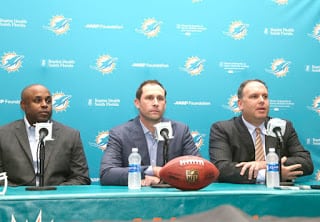 |
| Chris Grier, Adam Gase and Mike Tannenbaum building a winner. |
The primary objective of the off-season was to shore up a
defense that allowed 69 points in two meetings with the kings of the AFC East,
New England Patriots. Those needs were magnified on a national stage when the
Dolphins were put out to pasture by the explosive Pittsburgh Steelers’ offense
in the wildcard round.
defense that allowed 69 points in two meetings with the kings of the AFC East,
New England Patriots. Those needs were magnified on a national stage when the
Dolphins were put out to pasture by the explosive Pittsburgh Steelers’ offense
in the wildcard round.
Preaching a plan and executing it are two separate entities.
Rather than throwing money at the most expensive players free agency has to
offer, Miami continued to build depth and address roles of need. What are those
roles?
Rather than throwing money at the most expensive players free agency has to
offer, Miami continued to build depth and address roles of need. What are those
roles?
- Improve
the run defense on the perimeter and inside the tackles - Compliment
Cam Wake with another pass rush specialist - Remake
the linebacker group with players of opposing strengths
I would add to that list that Miami would have preferred to
generate more stability on the interior offensive line and bulk up the
secondary both with depth and starting caliber players. Neither of those goals
were accomplished, but there are probably only three teams that have but one or
two weaknesses and the Dolphins are not one of those teams.
generate more stability on the interior offensive line and bulk up the
secondary both with depth and starting caliber players. Neither of those goals
were accomplished, but there are probably only three teams that have but one or
two weaknesses and the Dolphins are not one of those teams.
Yet.
This spreadsheet indicates a projected look at the 53-man
roster and expected snap count percentages. I realize there are 54 players
not-including specialists, but that’s because it’s April and there are
positions to be won. Lastly, there will certainly be an undrafted free-agent or
two to make the squad.
roster and expected snap count percentages. I realize there are 54 players
not-including specialists, but that’s because it’s April and there are
positions to be won. Lastly, there will certainly be an undrafted free-agent or
two to make the squad.
(Use Scroll bar on Spreadsheet above to see entire projected depth chart)
The reinforcements allocated to the run defense should be
the most enticing for Dolphins fans. Running the football on the Dolphins in
December the last two seasons was far too easy – and it wasn’t exclusive to the
final month of the season. The Titans had a possession in an October meeting
that featured 11 consecutive running plays moving the ball 75 yards before
throwing for a touchdown.
the most enticing for Dolphins fans. Running the football on the Dolphins in
December the last two seasons was far too easy – and it wasn’t exclusive to the
final month of the season. The Titans had a possession in an October meeting
that featured 11 consecutive running plays moving the ball 75 yards before
throwing for a touchdown.
Reshad Jones comes back to destroy outside runs to the
strong-side C gap – and there’s no one in football better at it.
strong-side C gap – and there’s no one in football better at it.
William Hayes comes over from Los Angeles to play the left
side on base downs and kick inside on nickel packages.
side on base downs and kick inside on nickel packages.
Raekwon McMillan should be the SAM linebacker and he was
probably the best tackler available in the 2017 NFL Draft. He doesn’t take
false steps, quickly and correctly diagnoses and cleans up anything in his area
in the run game.
probably the best tackler available in the 2017 NFL Draft. He doesn’t take
false steps, quickly and correctly diagnoses and cleans up anything in his area
in the run game.
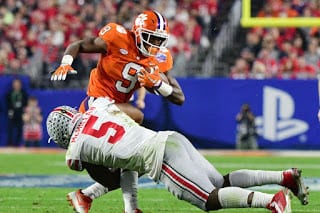 |
| Raekwon McMillan was the best tackler in this draft. |
Those three factors will pay massive dividends defending the
runs and allowing the Dolphins to use those specialty rushers more frequently.
runs and allowing the Dolphins to use those specialty rushers more frequently.
Enter Charles Harris. The Dolphins defense goes ice-cold
when Cam Wake hits a passing-game-disruption slump and adding Harris as a
pure-rusher in his rookie year should help pick up the slack.
when Cam Wake hits a passing-game-disruption slump and adding Harris as a
pure-rusher in his rookie year should help pick up the slack.
Lawrence Timmons can cover, blitz and influence passing
lanes in a number of ways. Best of all, he relegates Kiko Alonso to a role
better suited for his skillset – the WILL linebacker.
lanes in a number of ways. Best of all, he relegates Kiko Alonso to a role
better suited for his skillset – the WILL linebacker.
Going from a banged up Jelani Jenkins, Spencer Paysinger,
Mike Hull and Neville Hewitt playing significant reps late in 2016 to this
re-made group of linebackers should change the landscape of the Dolphins
defense for the better.
Mike Hull and Neville Hewitt playing significant reps late in 2016 to this
re-made group of linebackers should change the landscape of the Dolphins
defense for the better.
The recipe for the stop-unit relies upon the health of
Jones, Wake and Suh and can hardly afford to lose more than one linebacker or
corner to a significant injury. Keeping this thin group healthy and fulfilling
these specified roles could see the defense jump from a bottom tier unit to at
least a middle-of-the-pack group.
Jones, Wake and Suh and can hardly afford to lose more than one linebacker or
corner to a significant injury. Keeping this thin group healthy and fulfilling
these specified roles could see the defense jump from a bottom tier unit to at
least a middle-of-the-pack group.
And that might be all the offense needs.
The offensive line was the big area of concern entering the
weekend, and the off-season in general. As the free-agent market played out, a
lot of middle-of-the-road linemen got paid like elite all-pros.
weekend, and the off-season in general. As the free-agent market played out, a
lot of middle-of-the-road linemen got paid like elite all-pros.
Eschewing that market and filling the group with depth and
competition was the strategy. We won’t know the result of that plan for another
10 months – but it’s an admirable approach.
competition was the strategy. We won’t know the result of that plan for another
10 months – but it’s an admirable approach.
Although there were 163 players drafted ahead of him, Isaac
Asiata stands atop the podium as the Dolphins biggest “get” on the line.
Asiata stands atop the podium as the Dolphins biggest “get” on the line.
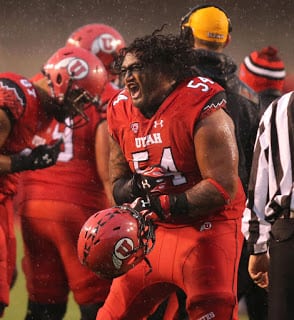 |
| The Dolphins new guard plays with intellect and passion. |
He’s a mauling guard with quick feet that played a lot of
games and paved the way for a dominant rushing attack at Utah. He’s massive,
strong and should help Miami deal with the big defensive tackles in the AFC East
– as evident by his 35 bench-press reps. He does need to work on staying more
in control, but he offers the Dolphins scheme versatility at the position.
games and paved the way for a dominant rushing attack at Utah. He’s massive,
strong and should help Miami deal with the big defensive tackles in the AFC East
– as evident by his 35 bench-press reps. He does need to work on staying more
in control, but he offers the Dolphins scheme versatility at the position.
Mike Pouncey is sort of the glue to the entire puzzle up
front. His health should not be counted on, and the insurance is far better
with Ted Larsen than it was in 2016 with Anthony Steen and Kraig Urbik.
front. His health should not be counted on, and the insurance is far better
with Ted Larsen than it was in 2016 with Anthony Steen and Kraig Urbik.
Regardless, continuity up front is a necessity for a zone
blocking scheme and a second year in the program that saw marked improvement
from week six onward.
blocking scheme and a second year in the program that saw marked improvement
from week six onward.
The same holds true with the chemistry and synchronicity in
the passing game. Things slowed down exponentially after the bye week for Ryan
Tannehill and Kenny Stills and Devante Parker become more prolific
contributors.
the passing game. Things slowed down exponentially after the bye week for Ryan
Tannehill and Kenny Stills and Devante Parker become more prolific
contributors.
Adding Anthony Fasano to a group of tight-ends that didn’t
have a plus blocker outside of third tight-end, Marqueis Gray, gives the
outside-zone game much more hope.
have a plus blocker outside of third tight-end, Marqueis Gray, gives the
outside-zone game much more hope.
Julius Thomas is the mismatch piece when the Dolphins trot
out the three-by-one sets where an inline tight end is often isolated against a
safety or linebacker. Like Pouncey, his health is a question-mark, yet
paramount to the plan coming together for this team. No team in the NFL runs
more plays from this formation than Miami.
out the three-by-one sets where an inline tight end is often isolated against a
safety or linebacker. Like Pouncey, his health is a question-mark, yet
paramount to the plan coming together for this team. No team in the NFL runs
more plays from this formation than Miami.
This offense isn’t going to regress. Branden Albert was a
bad and unreliable player in his final year with the team. Laremy Tunsil was a
good guard, but he is an elite tackle. Ja’Wuan James strung together some
quality performances late and Jermon Bushrod now has a full year of interior
line play (had only ever played tackle prior to 2016) and a healthy shoulder.
bad and unreliable player in his final year with the team. Laremy Tunsil was a
good guard, but he is an elite tackle. Ja’Wuan James strung together some
quality performances late and Jermon Bushrod now has a full year of interior
line play (had only ever played tackle prior to 2016) and a healthy shoulder.
The difference between a .500-team and a 12-win team that
hosts a divisional-round playoff game can be a miniscule margin. The Dolphins
will flirt with those odds in 2017 as the roster has the make-up of great
potential – but just as that potential can rise-up, it can crumble like aging
lawn-furniture.
hosts a divisional-round playoff game can be a miniscule margin. The Dolphins
will flirt with those odds in 2017 as the roster has the make-up of great
potential – but just as that potential can rise-up, it can crumble like aging
lawn-furniture.
The floor for
this team is eight wins. Even a two-win regression might not mean the team was
substantially worse, but rather that a few bad-breaks fell against the
Dolphins.
this team is eight wins. Even a two-win regression might not mean the team was
substantially worse, but rather that a few bad-breaks fell against the
Dolphins.
The ceiling for
this team is 12 wins and an AFC title-game appearance. If the rookie class
chips it with its expected contribution, the veterans stay-healthy and the
offense takes the next step, it’ll be a fun season for The New Miami.
this team is 12 wins and an AFC title-game appearance. If the rookie class
chips it with its expected contribution, the veterans stay-healthy and the
offense takes the next step, it’ll be a fun season for The New Miami.
If Tannehill’s knee hasn’t fully recovered, Cam Wake starts
to show his age, Laremy Tunsil misses extended action, Charles Harris can’t
beat NFL tackles and the injury bug bites, it could be a lost season.
to show his age, Laremy Tunsil misses extended action, Charles Harris can’t
beat NFL tackles and the injury bug bites, it could be a lost season.
As it stands now, five months and change from the season
opener, I land somewhere in the middle predicting a nine or 10-win season with another
difficult road wildcard game in the forecast.
opener, I land somewhere in the middle predicting a nine or 10-win season with another
difficult road wildcard game in the forecast.
Follow me on Twitter @travis_writes
Before we get to the games, training camp should have some
intriguing battles. Come back later in the week to read up on those battles and
who has the early leg-up before the team hits organized team activities.
intriguing battles. Come back later in the week to read up on those battles and
who has the early leg-up before the team hits organized team activities.


